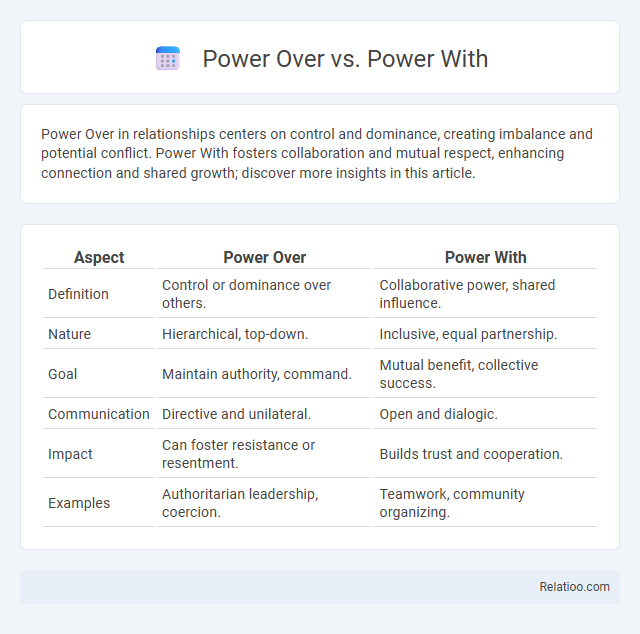Power Over in relationships centers on control and dominance, creating imbalance and potential conflict. Power With fosters collaboration and mutual respect, enhancing connection and shared growth; discover more insights in this article.
Table of Comparison
| Aspect | Power Over | Power With |
|---|---|---|
| Definition | Control or dominance over others. | Collaborative power, shared influence. |
| Nature | Hierarchical, top-down. | Inclusive, equal partnership. |
| Goal | Maintain authority, command. | Mutual benefit, collective success. |
| Communication | Directive and unilateral. | Open and dialogic. |
| Impact | Can foster resistance or resentment. | Builds trust and cooperation. |
| Examples | Authoritarian leadership, coercion. | Teamwork, community organizing. |
Understanding "Power Over" and "Power With
Power Over" represents a hierarchical dynamic where one person or group exerts control or dominance over another, often linked to traditional gender roles that reinforce inequality. "Power With" emphasizes collaboration and shared influence, promoting mutual respect and equality, essential for challenging stereotypical gender roles. Your understanding of these concepts can help foster more balanced and inclusive relationships, breaking down power imbalances rooted in gender expectations.
Historical Context of Power Dynamics
Power Over reflects hierarchical dominance rooted in historical patriarchal systems where authority was centralized and often linked to gender, particularly favoring male leadership. Power With emerged as a response to oppressive structures, emphasizing collaboration and shared influence, challenging traditional gender roles that restricted women's participation in decision-making. Gender roles historically reinforced unequal power distributions by prescribing specific social behaviors and responsibilities, which marginalized certain groups and maintained inequitable access to power resources.
Defining Characteristics of "Power Over
Power Over is defined by hierarchical authority where one individual or group exerts control and dominance over others through coercion, force, or influence, often leading to unequal power dynamics. It emphasizes unilateral decision-making and the ability to impose will without mutual consent, contrasting sharply with collaborative or shared power models. This form of power reinforces traditional gender roles by perpetuating authority typically aligned with patriarchal or male-dominant structures.
Defining Characteristics of "Power With
Power With" emphasizes collaborative influence and shared decision-making, contrasting with hierarchical or unilateral control typical of "Power Over." It fosters collective empowerment, mutual respect, and interdependence, challenging traditional gender roles that often associate power with dominance and authority. This approach promotes inclusivity and egalitarian interactions, particularly significant in reshaping gender dynamics toward cooperation rather than competition.
Impact of Power Dynamics on Relationships
Power over involves one party exerting control or dominance, often leading to imbalanced relationships that can foster resentment and reduce cooperation. Power with emphasizes collaboration and shared authority, promoting mutual respect and stronger, more equitable relationships. Understanding your role within gender dynamics can influence how power is negotiated and expressed, impacting emotional intimacy and conflict resolution.
Advantages of Collaborative Power
Collaborative power, or power with, fosters inclusive decision-making by emphasizing shared authority and mutual respect, which leads to improved problem-solving and innovation. Unlike power over, which relies on hierarchy and control, collaborative power enhances trust and cooperation among team members, promoting a balanced approach to gender roles. This egalitarian dynamic encourages diverse perspectives and equitable participation, ultimately driving organizational effectiveness and social harmony.
Disadvantages of Dominative Power
Dominative power often leads to toxic environments where collaboration and trust are eroded, negatively impacting productivity and morale. When power is exercised over others, it can reinforce harmful gender roles by perpetuating inequality and limiting opportunities for marginalized groups. Your ability to foster inclusive and respectful relationships is compromised when dominative power dynamics dominate social and professional settings.
Power Dynamics in Leadership and Organizations
Power Over in leadership emphasizes hierarchical control where authority is exercised top-down, often limiting collaboration and stifling employee empowerment. Power With fosters shared influence and mutual respect, encouraging inclusive decision-making and enhancing collective organizational effectiveness. Understanding these distinctions helps Your leadership approach promote equitable gender roles by challenging traditional norms and supporting diverse power dynamics.
Transforming "Power Over" into "Power With
Transforming "Power Over" into "Power With" shifts the dynamic from control and dominance to collaboration and mutual respect, essential for dismantling traditional gender roles that often perpetuate inequality. Empowering Your interactions by fostering inclusive dialogue and shared decision-making creates environments where diverse perspectives thrive, challenging hierarchical power structures. Embracing "Power With" enables the redefinition of gender roles, promoting equity and collective strength within organizations and communities.
Building a Culture of Shared Empowerment
Power Over represents hierarchical authority where control is exerted from one individual or group over others, often reinforcing traditional gender roles and limiting collaborative potential. Power With emphasizes collective strength and mutual support, fostering an inclusive environment that challenges rigid gender norms and promotes shared decision-making. Building a culture of shared empowerment requires integrating Power With dynamics to create equitable spaces where diverse gender identities contribute equally to organizational growth and innovation.

Infographic: Power Over vs Power With
 relatioo.com
relatioo.com